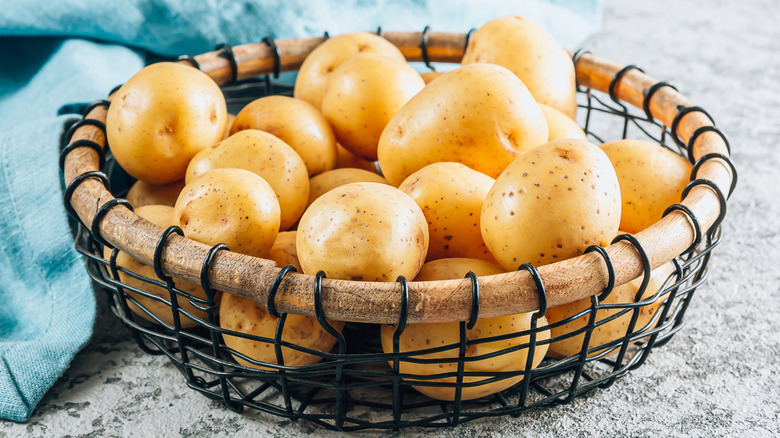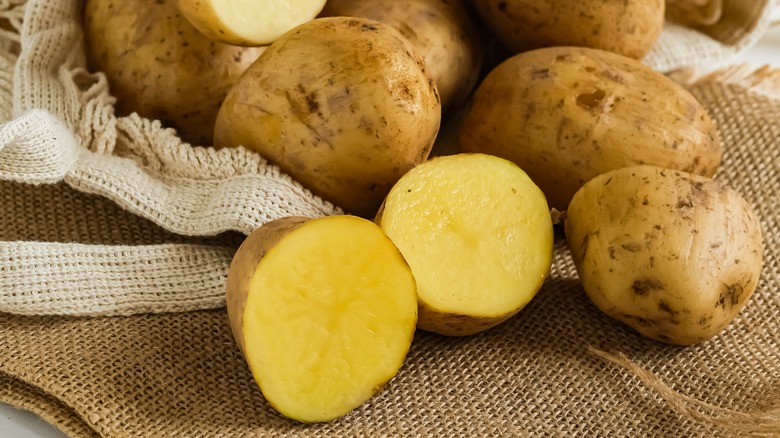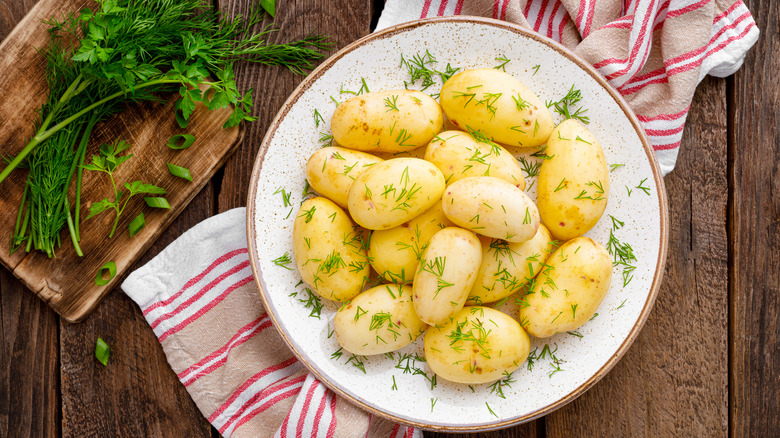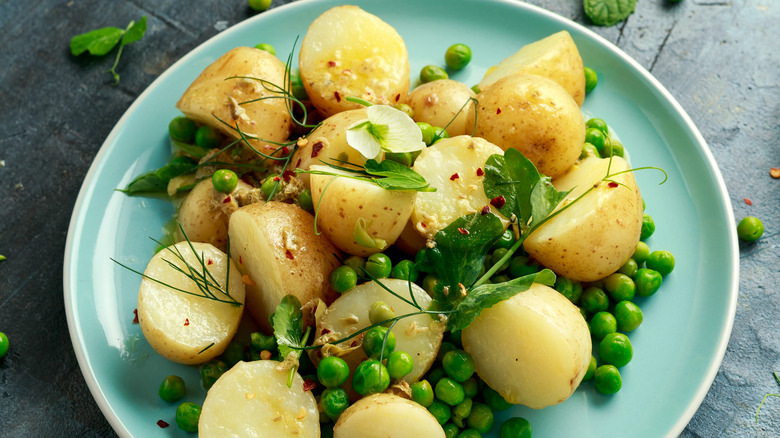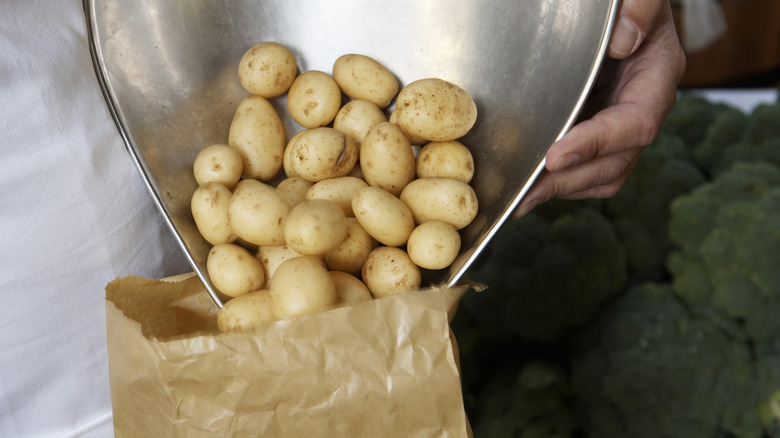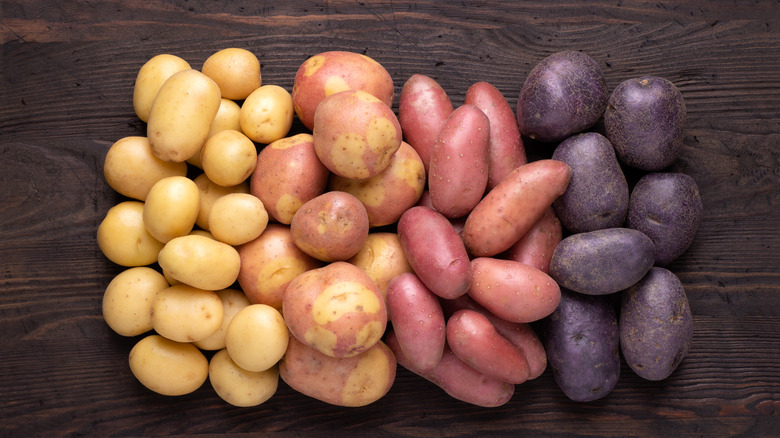What Is A New Potato And How Should You Cook With It?
New potatoes are a delicious and versatile ingredient that many people may not be familiar with. New potatoes, scientifically known as Solanum tuberosum, are small, young potatoes that are harvested before they have a chance to fully mature and develop a thick skin (via Science of Cooking). This annual plant is a part of the nightshade family and is typically harvested in the spring and early summer.
New potatoes are known for their unique texture and taste. They have a firm, waxy texture and a delicate, sweet flavor that sets them apart from regular potatoes (via BBC Good Food). They are also high in moisture and low in starch, which makes them ideal for roasting, boiling, or sautéing. But another notable element of new potatoes is that they have a thin, delicate skin that is edible.
New potatoes are available in many supermarkets and farmer's markets during the spring and summer months (via LA Times). They are typically sold in small bags or by the pound, and are often labeled as "new potatoes" or "baby potatoes". But before you start looking for them near you, there is so much to know about new potatoes and what sets them apart from typical tubers.
This is how new potatoes are grown
New potatoes are grown in much the same way as regular potatoes. They are planted in the spring, typically in fields that have been properly prepped (via Garden Design). The plants grow and produce small, green leaves that eventually flower and produce small tubers.
Once the plants are mature, they are ready to be harvested. The process of harvesting new potatoes is a delicate one, as the tubers are small and easily damaged (via Epic Gardening). Typically, the soil is gently loosened and the tubers are then pulled from the ground. After harvesting, the new potatoes are cleaned and sorted by size and quality. They are then packaged and sent to the market, where they can be found at farmer's markets and supermarkets.
One of the benefits of new potatoes is that they have a shorter growing season compared to mature potatoes (via How to Grow Potatoes). This means that farmers can plant and harvest multiple crops in one season.
Key differences between new potatoes and regular potatoes
New potatoes and regular potatoes are both varieties of the same plant, but there are a few key differences between them. New potatoes are harvested before they have a chance to fully mature and develop a thick skin (via How to Grow Potatoes). They are typically harvested in the spring and early summer and have thin, delicate skin that is edible. Regular potatoes, on the other hand, are harvested later in the season and have thicker, inedible skin.
Another difference is the texture and taste. New potatoes have a firm, waxy texture and a delicate, sweet flavor that sets them apart from regular potatoes (via BBC Good Food). They are also high in moisture and low in starch, which opens them up to a variety of cooking methods (via All About Potatoes). Regular potatoes, however, have a drier and more mealy texture and are better suited to baking and mashing.
New potatoes are also smaller than regular potatoes according to All About Potatoes. They are also more perishable than mature potatoes and should be stored in a cool, dark place and consumed within a few days according to the LA Times. Regular potatoes, however, can be stored for several weeks in a cool, dark place and have a longer shelf life.
What do new potatoes taste like?
New potatoes have a unique and delicious taste that sets them apart from regular potatoes. According to Master Class, they are known for their delicate, sweet flavor and firm, waxy texture.
When you first take a bite of a new potato, you'll notice its natural sweetness. This sweetness is a result of the high sugar content in the potato that hasn't had a chance to convert to starch yet according to the LA Times. The sweetness is subtle but noticeable, making them a perfect ingredient for dishes where you want to highlight the natural flavors of the ingredients.
The texture of new potatoes is firm and also contributes to the taste of the young potatoes. Their high moisture content ensures they retain their texture and don't fall apart while cooking according to Master Class. The skin is thin and delicate, making it easy to eat and adding an extra layer of flavor to your dish.
How to cook new potatoes
New potatoes are versatile ingredients that can be cooked in a variety of ways to bring out their delicious taste and texture. Some of the best ways to cook new potatoes include boiling, roasting, sautéing, grilling, and steaming.
Boiling is one of the simplest and most popular ways to cook new potatoes. Simply place the potatoes in a pot of boiling water and cook until tender and creamy (via The Spruce Eats). Once cooked, drain the potatoes and toss them with butter and herbs for a simple and delicious side dish.
According to The Spruce Eats, you can also roast new potatoes. Cut the potatoes into wedges or chunks and toss them with oil, herbs, and spices. Roast in a preheated oven until golden brown and crispy. Roasting new potatoes bring out their natural sweetness, making a crispy exterior.
Sauté the potatoes into small cubes and sauté them in a pan with oil, butter, or bacon grease until they are golden brown and tender (via Food). This method is perfect for making a simple and delicious breakfast side dish.
Cook new potatoes in the summer by adding them to the grill (via Weber). Cut the potatoes into wedges or chunks, toss with oil and herbs, and grill until tender and lightly charred. The smoky flavor of the grill contributes an extra dimension of flavor to the potatoes.
For a healthy and easy way to cook new potatoes, try steaming them (via My Therapist Cooks). Simply place the potatoes in a steamer basket over a pot of boiling water and cook until tender. Steaming preserves the nutritional value of the potatoes and keeps their delicate texture.
Where to buy new potatoes
New potatoes are a seasonal ingredient that is typically available in the spring and early summer. They can be found at a variety of retailers, including supermarkets, farmer's markets, and specialty food stores (via The Spruce Eats).
One of the best places to buy new potatoes is at a farmer's market. Farmer's markets offer a wide variety of locally grown produce, including new potatoes. Shopping at a farmer's market allows you to meet the farmers who grow the potatoes and ask them questions about their growing methods. They also tend to be fresher, as they have been recently harvested, and often come in small quantities, perfect for small households.
Another great place to buy new potatoes is at a specialty food store. Specialty food stores often carry a wide variety of seasonal produce, including new potatoes. They often have a wide selection of new potatoes that may not be available in supermarkets.
The supermarket is also a great place to buy new potatoes. They usually carry new potatoes during the spring and early summer months. They may not always have a wide variety, but they are easily accessible and can be found in most locations.
When buying new potatoes, it's important to look for potatoes that are firm and have a consistent texture according to The Spruce Eats. Avoid potatoes that are soft, wrinkled, or have any signs of sprouting. It's also important to use them within a few days of purchase, as they are more perishable than mature potatoes.
Nutrition of new potatoes
New potatoes are a nutritious food that is a good source of several essential vitamins and minerals.
Firstly, they are a good source of potassium, a mineral that helps to regulate blood pressure and supports proper muscle and nerve function according to the Harvard School of Public Health. A 120-gram serving of new potatoes contains around 642 milligrams of potassium (via Nutritionix). The same serving size of new potatoes also contains 19 percent of the suggested daily intake of vitamin C and seven percent of the daily iron recommendations.
They are also a good source of dietary fiber, which is essential for maintaining a healthy digestive system. Fiber helps to promote regular bowel movements and may also help to lower cholesterol levels (via Mayo Clinic). A 120-gram serving of new potatoes contains just under three grams of dietary fiber.
New potatoes are also low in calories and fat. A 120-gram serving of new potatoes contains about 112 calories and 0.2 grams of fat. It also contains three grams of protein and 26 grams of carbohydrates.
It's worth noting that the nutritional content of new potatoes can vary depending on how they are prepared. Boiling or steaming new potatoes will preserve most of their nutritional value, while frying or roasting can add extra calories and fat.
Types of new potatoes
New potatoes come in a variety of types, each with its own unique flavor and texture. It is worth noting that any variety of potato can be "new potatoes" so long as they are young, freshly harvested potatoes that have not been cured. However, some types of potatoes can be harvested in just 110 days while others need up to 120 days (via Plantura).
Of the shorter growing period, popular varieties of new potatoes include Annabelle, Augusta, and Finka potatoes. A few popular varieties that require 120 days to grow include goldmarie, marabell, and red duke of york according to Plantura.
Each type of new potatoes has its own unique flavor and texture, and can be used in different dishes. Some of these varieties can be hard to find and might be seasonal. Be sure to try different types to find your favorite and explore new ways of cooking them.
